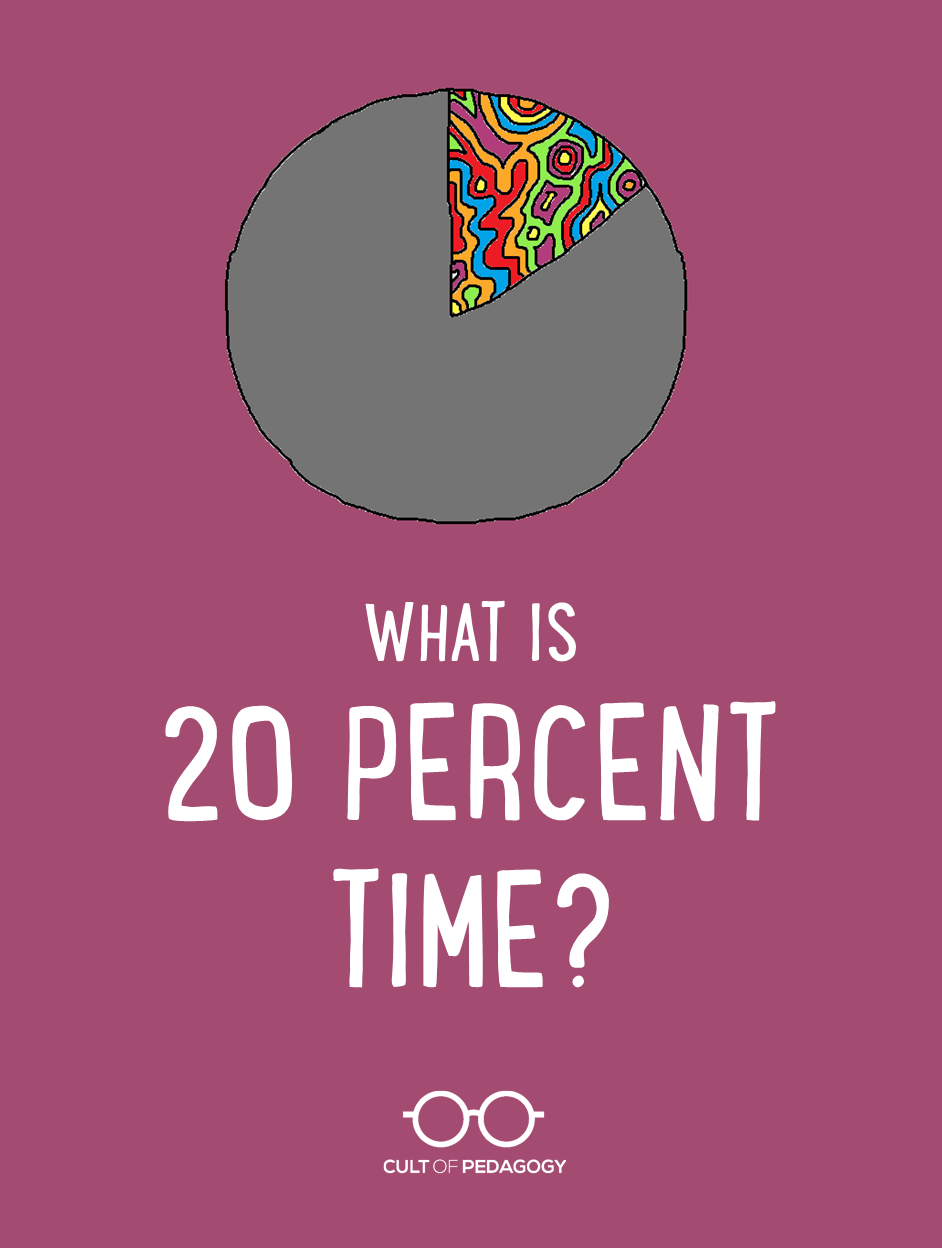
Listen to my interview with A.J. Juliani (transcript):
Imagine if someone told you to take a whole day, once a week, to set your regular work aside and explore something you’re really passionate about. Want to learn to speak Italian? Go ahead. Always wished you could improve your photography? Get on it. Just think classic cars are really cool? Off you go, then.
That’s pretty much the gist of 20 percent time, a term that comes from Google’s policy of allowing its employees to spend 20% of their time “working on what they think will most benefit Google.” The trend is starting to catch on in schools, where teachers are regularly setting aside class time to allow students to pursue their passions, sometimes with an academic focus, and sometimes under a more “anything goes” policy.
When I started looking into the 20-Time movement in education, the name A.J. Juliani kept popping up. Juliani first implemented 20% Time several years ago with his eleventh-grade English classes. Since then he’s moved on to helping other teachers implement this approach in their own classrooms, and he writes about and promotes the idea on his own and on other websites.

A.J. and I spoke a few weeks ago via Google Hangouts. He helped me get a clearer understanding of what the process looks like from start to finish, how he and others handle grading, and what problems he encountered along the way. Below is just a bit of our conversation. To hear the full interview, scroll down and choose a listening option.
————–
JG: When you first introduced this concept to your students, what did you tell them?
AJ: I said look, I know you’re in eleventh grade, and you’re motivated extrinsically by grades, and pretty much your whole life you’ve just been playing this game of school, right? Teacher tells you to do this, if you do it well, you get this grade and you move on. And that’s it, right? But the real world doesn’t necessarily work like that.
JG: Did you have problems with some students who saw 20% time as a “slack day,” who just wanted to do nothing?
AJ: All the research says that extrinsic motivation just doesn’t work as well as intrinsic motivation. I share that information with my students and with other teachers as well…But you still have students who are going to balk for two reasons.
Number one, this is not how school is supposed to be. For years they’ve been working and just following the same system of how school works. And then you flip it on its head and they’re kind of angry. To those students I say when you leave high school, no one is telling you what to do with eight hours of your day. You have to make all of the decisions. How can you possibly be successful if the only way you have found to be successful is following the rules that other people have set out?
The other set of students that might slack off are the ones that say “I don’t really have any interests. I don’t have any passions.” For those students I’d have them do activities to help them figure out what they actually like doing. I’d have them fill out this sheet with four questions: (1) What do you do when you’re supposed to be doing something else like homework? (2) What do you do in your free time? (3) If you had the chance to get your dream job right now, what would that job be? (4) In ten years, what do you want your lifestyle to look like?
JG: What would someone see if they walked into your classroom during 20 percent time?
AJ: They would see chaos. And I’m not even saying organized chaos. They would see some students out in the hallway, some outside, some on computers, some working in groups, some talking to me. But then they would probably see a student doing something cool, and go over and have a conversation with them, and then be really drawn in.
And my role as the teacher was…not like a ‘guide on the side’ but more of a coach. When I was a football coach I had eleven players on the field doing eleven different things. As a coach (my responsibility is) that they all know what they’re supposed to be doing, that they have had training and practice, so when it’s actually game day, those eleven people can actually do something to make something successful happen. I was doing the same thing in the classroom.
JG: Is any topic allowed? What if a kid wants to study bomb-making or pornography?
AJ: The whole thing is, from the get-go, saying “You can study anything you want, but this is still school.” A lot of times when people talk about thinking outside the box, they don’t understand that there’s another box around that box.
JG: Is there a “wrong” way to do 20 percent time?
AJ: The worst thing you can do is assign this project and then sit back and say, Alright, it’s on you guys, 20 percent time, learn what you want! I’m here if you need me! That’s the worst way you can do it. It doesn’t work out. The teacher has to be more active in this learning experience than anything else. Because students need coaching. They need to be connected to the right resources, to the right people. They need help on their projects. There are going to be pitfalls and failures, and they need someone there to kind of say that’s okay, that’s what it’s all about. ♦
To Learn More
There seems to be no end to the online and print resources surrounding this topic. I’ll start with the ones mentioned in this podcast, then add a few more good ones after that.
The Beginner’s Guide to 20% Time in Education
For a quick overview of how 20% time works, take a look at Juliani’s infographic, The Beginner’s Guide to 20% Time in Education.
Designing 20% Time in Education
This 2013 article on setting up 20% time in your classroom provides a comprehensive collection of research, related articles, and other resources to get you started.
GRIT Rubric
The GRIT Rubric A.J. mentions in the interview is one way teachers measure student effort and work habits during 20 percent time. If you want to add more structure and accountability to this time, this would be a great resource.
Websites
Genius Hour / 20% Time Livebinder
Books
The links in this section are Amazon affiliate links; we receive a small commission on purchases made through these links.
Juliani’s newest book, Inquiry and Innovation in the Classroom: Using 20% Time, Genius Hour, and PBL to Drive Student Success, offers an in-depth study of the research, logistics, and troubleshooting of student-centered, authentic learning arrangements.
In our interview, Juliani mentions Drive: The Surprising Truth About What Motivates Us, by Daniel Pink (2011), as a big contributor to his getting interested in trying something in his classroom to take advantage of the power of intrinsic motivation.
Pure Genius: Building a Culture of Innovation and Taking 20% Time to the Next Level, by Don Wettrick (2014) is another new book about implementing this process in the classroom.
The Passion-Driven Classroom: A Framework for Teaching and Learning, by Angela Maiers and Amy Sandvold (2010) is one of the earliest books on teaching with students’ passion in mind. It is often referred to in discussions of changing the way we teach to make learning more relevant to students.
If this one spoke to you, I’d love to have you come back for more. Join my mailing list and get weekly tips, tools, and inspiration — in quick, bite-sized packages — all geared toward making your teaching more effective and joyful. To thank you, I’ll send you a free copy of my new e-booklet, 20 Ways to Cut Your Grading Time in Half. I look forward to getting to know you better!





Jenn, I start 20% time with my juniors in 2 weeks. All because of your podcast. Yesterday, I introduced the concept to students, and the reaction was–well, I’ll describe it as wide-eyed-wonder. My kids aren’t used to being treated like adults (or even people), so they thrive when I do. Anyway, thanks for all you do!! And I bought AJ Juliani’s book, and it’s a goldmine!!
I will immediately seize your rss as I can’t find your
email subscription link or newsletter service. Do you have any?
Kindly permit me realize so that I may just subscribe.
Thanks.
Hi there ~ If you go to the “About” tab in the menu, there is a “Subscribe” option. Also, at the end of this post, there’s a gray box that provides instructions for subscribing. I hope this helps!
Great web site. Lots of helpful information here.
I am sending it to several friends ans additionally sharing in delicious.
And certainly, thank you to your effort!